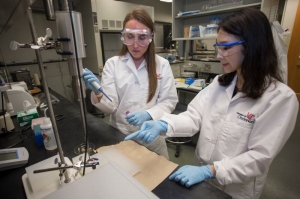Oct 12 2015
“Colloidal delivery system” and “nanoparticle” are probably not terms you find yourself using in day-to-day interactions, but for UC's Yoonjee Park, assistant professor in the College of Engineering and Applied Science biomedical engineering professor, these words are central to every conversation relating to her cutting edge research on drug delivery vehicles.
 Courtney Collins and Dr. Park discuss optimal techniques for particle synthesis.
Courtney Collins and Dr. Park discuss optimal techniques for particle synthesis.
A relatively recent addition to the university, Park is a “top-talent” educator who was recruited for her leadership in a “high-impact, high-demand area” in which the university wants to continue to position itself as a global leader.
The area in which Park has established herself as an expert is the field of study related to the creation and monitoring of delivery vehicles that carry medicine to specific locations within the body.
Park was first inspired to pursue this course of study when she saw the side effects of cancer and how the drugs used to kill cancer cells also killed other parts of the body. Regarding chemotherapy she explains, “If you inject the drug intravenously it can go anywhere and everywhere, which is why we get side effects like hair loss.”
She hoped to find a way of sending drugs only to the specific area of the body that needed the treatment rather than inadvertently treating (and harming) the whole body. In doing this, the medical treatment would be more effective and the patient could remain stronger during treatment.
Describing her work she says, “Usually I use nanoparticles for drug delivery vehicles, and we can attach image and contrast agents to the nanoparticle [to track the particle]. Or the nanoparticle itself is the image and contrast agent which makes a complex of the image and contrast agent with the drug itself.”
In the course of time Park began to focus her efforts on those parts of the body that posed a significant challenge or risk to doctors who are trying to reach that locale with medicine. Two areas that have been of particular interest to her are spinal discs and places within the eyeball, both of which can be painful and risky to access with traditional methods.
Since April, Park has been working with James Lin, director of the Skeletal Tissue Evaluation and Engineering Laboratory, to specifically focus on the regeneration of spinal disc degeneration. So far the two have been making great strides.
“While we are aging, the discs between the bones are wearing out so severely that some patients feel extreme pain, however addressing this pain is challenging,” explains Professor Park. Using vehicles made with perfluorocarbons, Park and Lin have created bio-safe, durable, reliable vehicles that can be inserted into the discs and traced via medical imaging.
Lin says that these vehicles, described as “droplets,” enter the bloodstream and are tracked “without opening up the body” to provide real time feedback and manipulation. Park says, “We can see the dosage in our bodies and we can see the drug bio-distribution. So we can minimize the side effects before something happens.”
The drug delivery systems Park and Lin have designed can be filled with the prescribed drug and inserted a single time into the spinal disc. Then, using a precisely calibrated ultrasound, the vehicles can be “popped” to systematically release the drug as needed. This technique allows for minimized invasive treatment, thus reducing the risk of harmful side effects, as well as creating a delivery system that can potentially be self-administered by the patient.
Lin says that his favorite part of his collaboration with Park has been that studying this drug delivery system has much wider applications and “the potential gives you an additional opportunity to make entire body repair schemes.” In fact, he relates that using the ultrasound technique to burst microbubbles has been used to break up blood clots that might otherwise have led to strokes.
Preliminary testing of the drug delivery procedure is being performed at the Laboratory Animal Medical Services (LAMS) facility on UC’s East Campus. Currently Park is in the preclinical phase, which she and Lin hope will lead to enough evidence regarding the safety and efficacy of the treatment to convince the FDA to allow them to move to clinical trials. Because this is a new application for an old drug, the two expect less challenges from the FDA than if they were trying to introduce an entirely new drug to the market.
Thankfully UC provides all of the necessary facilities, equipment, and resources for Park to pursue her research in tandem to her responsibilities as a professor. In fact, it was the superb medical facilities she would have access to as a professor at UC that aided in her decision to accept the position at the university. At the University of Cincinnati, Park is certain she will be able to go far in her research.
“Many people have been trying,” says Park of her attempt to create an effective drug delivery vehicle, and she herself is no stranger to this work, having spent a decade focusing on issues related to this project. Her PhD at Purdue University and her research at Boston’s Massachusetts Institute of Technology were both dedicated to studying particle stabilization to avoid clogging arteries with the nanoparticles and drug delivery vehicles; creating a vehicle that could be programmed to travel to specific destinations; tracking this vehicle with medical imaging; and learning how drugs could be time-released at the proper time.
With the support of the University of Cincinnati behind her efforts, Park hopes to be able to overcome the barriers that have slowed others, and reach the success she has been seeking. “It seems like it’s working! We’ve had lots of progress, actually,” she says with a smile.